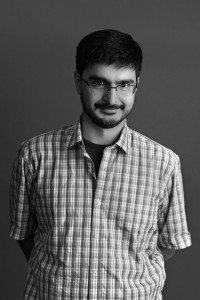This interview is part of an occasional series of profiles introducing you to the people behind 23andMe’s compelling research. In his  previous scientific life, Arnab Chowdry received a SmileTrain grant for his work with Dr. Simeon Boyadjiev at the Johns Hopkins Children’s Hospital to determine the disease-causing loci for rare genetic diseases such as oculodentodigital dysplasia, which causes abnormalities to many parts of the body particularly the eyes, teeth or fingers.
previous scientific life, Arnab Chowdry received a SmileTrain grant for his work with Dr. Simeon Boyadjiev at the Johns Hopkins Children’s Hospital to determine the disease-causing loci for rare genetic diseases such as oculodentodigital dysplasia, which causes abnormalities to many parts of the body particularly the eyes, teeth or fingers.
At 23andMe, Arnab is responsible for designing and establishing the analytical validity of our genotyping chip.
“We don’t just want to learn about genetics. We want to make genetics useful.”
How did you become excited about genetics?
I’ve been interested in genetics since high school. At that time, the human genome sequence was yet to be completed and I wondered why it was such a complicated problem. Being young, I had some very naive ideas about how we could improve the science.
During college, I was involved in research at Johns Hopkins which looked at rare variants. That introduced me to the common frustrations in the field of genetics at that time. There was a lot of noise around the publication of the first human genome, but practically it didn’t help my research. The genome was a draft and the region I was investigating was still largely unknown. To really advance medicine, we needed a faster way to assay mutations than what was available at the time.
After grad school, I came across 23andMe and thought, “if there’s any company that can realize these ideas, this is the one.” I had been in academics for years and had grown used to the hymn of “this new finding could be medically useful, in ten years.” Researchers get grants based around the potential to improve our lives but publications rarely connect their findings to a medical use case.
23andMe is different; we are working to make genetics useful today.
Originally from: Rochester, NY
BS/A: Johns Hopkins University
PhD: Biophysics from the University of California, Berkeley
Fun Fact: I like building things and breaking things.
Tell us about a recent breakthrough in genetics research that you think will have a big impact.
Next-generation sequencing is the breakthrough I’ve been waiting for. Currently, the genetic testing industry is very segmented. We have individual tests for the conditions we understand, but they’re slow, expensive, and their accuracy is poorly determined.
FDA-approved next-generation sequencing won’t replace all genetic tests, but it will commoditize a chunk of the industry, pushing consumers and physicians to evolve.
Reduced cost, improved accuracy and the establishment of new technologies is moving the needle both for clinical testing and research. (23andMe currently does genotyping, which tells customers your genotype at a certain subset of locations in your DNA. Full-genome sequencing tells you your genotype at every position.)
What interesting thing have you learned about yourself from being tested?
Even though I work for 23andMe as a scientist and engineer and I analyze genetic data for a living, up until 2012, my work had always been abstract. I never expected life-altering information to come out of my personal genetics. Then I found out that I carry a mutation in the MYBPC3 gene that is associated with familial hypertrophic cardiomyopathy (HCM). South Asians that carry this mutation are at greatly increased risk for HCM.
Since then, I’ve talked to my family, visited doctors and specialists and changed my exercise routine.
I’ve also worked with other researchers to uncover the biological ramifications of the genetic mutation and presented the findings at a national meeting of geneticists. You can read more about my experience here.
What’s one thing the average person should know about genetics?
People believe genetics to be more deterministic than it is. In fact, there is no “genes vs. environment” debate. Researchers understand that most complex diseases and traits are determined by a combination of genetic and environmental factors, neither of which should be ignored. If we — and our physicians — can take that view, it will help us to better understand ourselves and improve our lives.